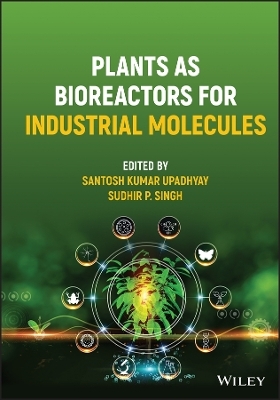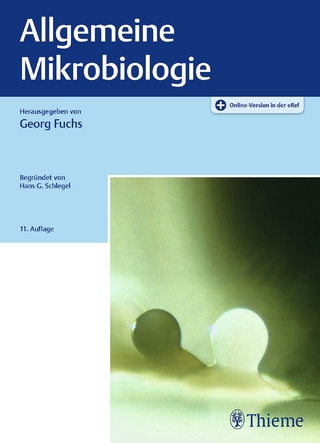
Plants as Bioreactors for Industrial Molecules
John Wiley & Sons Inc (Verlag)
978-1-119-87508-6 (ISBN)
In Plants as Bioreactors for Industrial Molecules, a team of distinguished researchers delivers an insightful and global perspective on the use of plants as bioreactors. In the book, you’ll find coverage of the basic, applied, biosynthetic, and translational approaches to the exploitation of plant technology in the production of high-value biomolecules. The authors focus on the yield and quality of amino acids, vitamins, and carbohydrates.
The authors explain how high-value biomolecules enable developers to create cost-effective biological systems for the production of biomolecules useful in a variety of sectors. They provide a holistic approach to plant-based biological devices to produce natural molecules of relevance to the health and agriculture industries.
Readers will also find:
A thorough overview of plants as bioreactors and discussions of molecular farming for the production of pharmaceutical proteins in plants
Comprehensive explorations of plants as edible vaccines and plant cell culture for biopharmaceuticals
Practical discussions of the production of attenuated viral particles as vaccines in plants and insecticidal protein production in transgenic plants
Extensive treatment of the regulatory challenges involved in using plants as bioreactors
Perfect for academics, scientists, and researchers in industrial microbiology and biotechnology, Plants as Bioreactors for Industrial Molecules will also earn a place in the libraries of biotechnology company professionals in applied product development.
Santosh Kumar Upadhyay is Assistant Professor in the Department of Botany at Panjab University in Chandigarh, India. He works in the area of plant molecular biology for the isolation, characterization, and recombinant production of various defense-related and industrial proteins. Sudhir P. Singh is a scientist of biotechnology and synthetic biology at the Center of Innovative and Applied Bioprocessing in Mohali, India. He works in the area of gene mining and biocatalyst engineering.
About the Editors xv
List of Contributors xvii
Preface xxiii
Acknowledgments xxv
1 Plants as Bioreactors: An Overview 1
Madhu, Alok Sharma, Amandeep Kaur, Deepika Antil, Sudhir P. Singh, and Santosh Kumar Upadhyay
1.1 Introduction 1
1.2 Factors Controlling the Production of Recombinant Protein 2
1.2.1 Choice of the Host Species 2
1.2.2 Optimization of Expression of Recombinant Protein 3
1.2.2.1 Transcription 4
1.2.2.2 Post- Transcription Modifications 6
1.2.2.3 Translation 7
1.2.2.4 Posttranslational Modifications (PTMs) of Recombinant Proteins 8
1.2.3 Downstream Processing 8
1.3 Recombinant Proteins in Plants 9
1.3.1 Pharmaceutical Proteins 9
1.3.2 Vaccine Antigens 13
1.3.3 Antibodies 14
1.3.4 Nutritional Molecules 15
1.3.5 Other Valuable Products 16
1.4 Conclusions 17
References 17
2 Molecular Farming for the Production of Pharmaceutical Proteins in Plants 29
Gaurav Augustine, Pragati Misra, Archana Shukla, Ghanshyam Pandey, and Pradeep Kumar Shukla
2.1 Introduction 29
2.2 Plant as an Expression Platform 30
2.3 Plant- Derived Recombinant Proteins 34
2.4 Engineering Strategies Utilized for Recombinant Pharmaceutical Protein Production in Plants 34
2.4.1 Nuclear Transformation 35
2.4.2 Chloroplast Transformation 37
2.5 Pharmaceutical Protein Developed Using Plant Expression Platform 37
2.6 Perspectives 46
2.7 Conclusion 47
References 47
3 Plants as Edible Vaccine 57
Jia Qi Yip, Jia Choo, Kirthikah Kadiresen, Megan Min Tse Yew, Ying Pei Wong, and Anna Pick Kiong Ling
3.1 Introduction 57
3.2 Mechanism of Action 59
3.3 Edible Plant Vaccines 60
3.3.1 Candidate Plants and Selection of Desired Gene 60
3.4 Production of Edible Vaccine (Plant Transformation) 61
3.4.1 Chemical- Mediated DNA Transfer Method 61
3.4.1.1 Polyethylene Glycol (PEG)- Mediated DNA Transfer Method 62
3.4.1.2 Liposome- Mediated DNA Transfer Method 62
3.4.1.3 Calcium Phosphate Coprecipitation 63
3.4.1.4 Diethylaminoethyl (DEAE) – Ddextran- mediated DNA Transfer Method 64
3.4.2 Direct Gene Delivery Method (Physical) 64
3.4.2.1 Biolistic Transfection 64
3.4.2.2 Electroporation 65
3.4.2.3 Sonication 65
3.4.2.4 Microinjection 66
3.4.3 Indirect Gene Delivery 66
3.4.3.1 Agrobacterium- Mediated Gene Transfer 66
3.4.3.2 Genetically Engineered Plant Virus 68
3.4.3.3 Virus- Like Particles (VLPs) 69
3.5 Plant Species Used as Vaccine Models 70
3.5.1 Potato 70
3.5.2 Rice 71
3.5.3 Banana 71
3.5.4 Tomato 72
3.5.5 Lettuce 72
3.5.6 Maize 73
3.5.7 Carrot 73
3.5.8 Alfalfa 73
3.6 Challenges 76
3.7 Conclusion 77
Ackowledgments 77
References 78
4 Plant Cell Culture for Biopharmaceuticals 89
Zeuko’o Menkem Elisabeth and Rufin Marie Kouipou Toghueo
4.1 Introduction 89
4.2 Plant Cultures 90
4.2.1 Plant Cell Cultures 90
4.2.2 Plant Tissue Culture 91
4.2.3 Plant Organ Cultures 92
4.3 Conditions for Plant Cell, Tissue, and Organ Culture 92
4.3.1 Culture Medium 92
4.3.2 pH 95
4.3.2.1 Plant Cell Growth Regulators (auxin, cytokinin, and gibberellin) 95
4.3.2.2 Auxins 95
4.3.2.3 Cytokinins 96
4.3.2.4 Gibberellins 96
4.3.2.5 Abscisic Acid (ABA) 96
4.4 Types of Plant Cell, Tissue, and Organ Culture 96
4.4.1 Embryo Culture 96
4.4.2 Somatic Embryogenesis 97
4.4.3 Genetic Transformation 97
4.4.4 Meristem Tip Culture 98
4.4.5 Organogenesis 98
4.4.6 Callus Culture (Callogenesis) 98
4.4.7 Adventitious Root/Hairy Root Culture (rhizogenesis) 98
4.4.8 Suspension Culture 99
4.4.9 Protoplast Fusion 99
4.4.10 Haploid Production 99
4.4.11 Germplasm Conservation 100
4.5 The Techniques Used in Plant Culture 100
4.5.1 Micropropagation in Medicinal Plants 101
4.5.1.1 Stage 0: Preparation of the Donor Plant 101
4.5.1.2 Stage I: Initiation Stage 101
4.5.1.3 Stage II: Multiplication Stage 102
4.5.1.4 Stage III: Rooting Stage 102
4.5.1.5 Stage IV: Acclimatization Stage 102
4.5.2 Elicitation 102
4.5.3 Transformed Tissue Cultures 103
4.5.4 Metabolic Engineering 104
4.6 Applications of Plant Cultures 104
4.7 Biopharmaceuticals 104
4.7.1 Biopharmaceuticals from Plants 105
4.7.1.1 Scale- up of Secondary Metabolites by Using Different Systems 107
4.7.1.2 Vaccines 110
4.7.1.3 Plantibodies 115
4.7.1.4 Proteins 115
4.7.2 The Effects of Production, Safety, and Efficacy 118
4.8 Conclusion 118
References 119
5 Microalgal Bioreactors for Pharmaceuticals Production 127
Rufin Marie Kouipou Toghueo
5.1 Introduction 127
5.2 Microalgae Strains Selection 128
5.3 Microalgae Cultivation 129
5.3.1 Factors Affecting the Growth and Productivity of Microalgae 130
5.3.1.1 Nutrients 130
5.3.1.2 Temperature 131
5.3.1.3 pH, Salinity, and Pressure 132
5.3.1.4 Light 132
5.3.1.5 Mixing 133
5.3.2 Methods and Systems for Microalgae Cultivation 134
5.3.2.1 Methods 134
5.3.2.2 Microalgae Cultivation Systems 136
5.4 Acquiring Biopharmaceuticals from Microalgae’s 137
5.4.1 Microalgae Harvesting 137
5.4.1.1 Flocculation and Ultrasound 138
5.4.1.2 Centrifugation 138
5.4.1.3 Filtration 138
5.4.1.4 Flotation 139
5.4.2 Biomass Dehydratation 139
5.4.3 Cell Disruption for Bioproducts Extraction 140
5.5 Microalgal Compounds and their Pharmaceutical Applications 141
5.5.1 Carotenoids 141
5.5.2 Polyunsaturated Fatty Acids 143
5.5.3 Polysaccharides, Vitamins, and Minerals 145
5.5.4 Proteins 145
5.6 Conclusions 147
References 147
6 Micropropagation for the Improved Production of Secondary Metabolites 161
Rupasree Mukhopadhyay
6.1 Introduction 161
6.2 Micropropagation for Production of Secondary Metabolites 163
6.3 Strategies to Improve Secondary Metabolite Production 165
6.3.1 Optimizing Culture Conditions 165
6.3.2 Selecting High- Producing Cell Lines 167
6.3.3 Organ Cultures 167
6.3.4 Precursor Feeding 168
6.3.5 Elicitation 168
6.3.6 Immobilization 170
6.3.7 Permeabilization 171
6.3.8 Genetic Transformation: Hairy Root Cultures and Shooty Teratomas 171
6.3.9 Biotransformation 172
6.3.10 Metabolic Engineering 173
6.3.11 Plant Bioreactors and Scale- up 174
6.4 Conclusions 176
References 176
7 Metabolic Engineering for Carotenoids Enrichment of Plants 185
Monica Butnariu
7.1 Background 185
7.2 Classification of Carotenoid Pigments 186
7.2.1 Carotenoid Hydrocarbons 191
7.2.2 Xanthophylls 192
7.2.3 Carotenoid Ketones 192
7.2.4 Carotenoid Acids 193
7.3 Aspects of the Mechanism of Carotenoid Biosynthesis 194
7.3.1 Premises of Metabolic Engineering 208
7.4 Concluding Remarks and Future Perspectives 209
References 210
8 Plant Genome Engineering for Improved Flavonoids Production 215
Monica Butnariu
8.1 Background 215
8.2 Structure, Diversity, and Subgroups 217
8.3 Flavonoid Biosynthesis 223
8.4 The Mechanism of Action of Flavonoids 229
8.5 The Role of Flavonoids in Food and Medicine 233
8.6 Concluding Remarks and Future Perspectives 236
References 236
9 Antibody Production in Plants 241
Vipin Kumar Singh , Prashant Kumar Singh , and Amit Kumar Mishra
9.1 Introduction 241
9.2 How Are Antigens Expressed in Plants? 242
9.2.1 Transient Expression of Antigens 242
9.2.2 Plant Virus Fusion Proteins 243
9.3 Plant- Derived Antibodies: Are There any Alternative Approaches? 244
9.4 Antibody Production in Plants: Advantages and Concerns 246
9.5 Conclusion and Prospects 247
References 248
10 Metabolic Engineering of Essential Micronutrients in Plants to Ensure Food Security 255
Swarnavo Chakraborty and Aryadeep Roychoudhury
10.1 Introduction 255
10.2 Metabolic Engineering of Crops for Increased Nutritional Value 256
10.2.1 Iron 256
10.2.2 Iodine 260
10.2.3 Zinc 260
10.2.4 Vitamin A 261
10.2.5 Vitamin B 6
263
10.2.6 Vitamin B 9 264
10.2.7 Vitamin E 265
10.3 Conclusion and Future Perspectives 266
Acknowledgments 266
References 268
11 Plant Hairy Roots as Biofactory for the Production of Industrial Metabolites 273
Nidhi Sonkar, Pradeep Kumar Shukla, and Pragati Misra
11.1 Introduction 273
11.2 Types of Metabolites and Industrial Metabolites 274
11.3 Secondary Metabolites 276
11.4 Importance of Secondary Metabolites 277
11.5 Enhancement of Secondary Metabolites 278
11.6 Hairy Roots 280
11.6.1 Hairy Roots 280
11.6.2 Hairy Roots in Plants and In vitro Production of Secondary Metabolites 281
11.7 Initiation of Hairy Root Cultures 282
11.7.1 Formation of Highly Proliferative Hairy Roots 282
11.7.2 Agrobacterium rhizogenes for Hairy Root Production and as a Biotechnology Tools 283
11.8 Large- Scale Production of Secondary Metabolites 285
11.9 Strategies Used In vitro 287
11.9.1 Why Hairy Root Culture? 289
11.10 Plants as Bioreactors 289
11.11 A Case Study 291
11.12 Conclusion 292
References 294
12 Microalgae as Cell Factories for Biofuel and Bioenergetic Precursor Molecules 299
D. Rodríguez- Zuñiga, A. Méndez- Zavala, O. Solís- Quiroz, J.C. Montañez, L. Morales- Oyervides, and J.R. Benavente- Valdés
12.1 Introduction 299
12.2 Microalgae that Produce Bioenergy and Biofuel Molecules 300
12.3 Biosynthesis of Molecules for Bioenergy and Biofuels in Microalgae 302
12.4 Biohydrogen Production 303
12.5 Starch Biosynthesis 303
12.6 Lipid Biosynthesis 304
12.7 Biochemical Regulation of BBPM Associated with Nutritional Conditions 306
12.8 Physical and Chemical Factors Promote the Accumulation of Molecules for Bioenergy and Biofuels 308
12.9 Light Intensity 308
12.10 Salts 308
12.11 Use of Organic and Inorganic Carbon Sources 309
12.12 Agitation 309
12.13 Photobioreactors to Produce Bioenergy and Biofuels 310
12.14 Open Pond Cultivation Systems 310
12.15 Closed Systems 310
12.16 Hybrid Systems 311
12.17 Conclusions 311
References 311
13 Metabolic Engineering for Value Addition in Plant- Based Lipids/Fatty Acids 317
Himani Thakkar and Vinnyfred Vincent
13.1 Introduction 317
13.2 Plant Lipids 318
13.3 Tag Synthesis in Plants 318
13.3.1 Fatty Acid Synthesis 318
13.3.2 Tag Biosynthesis 319
13.3.3 Lipid Droplets Biogenesis 320
13.3.4 Wax Esters Synthesis 321
13.4 Regulatory Factors Involved in Tag Synthesis 322
13.5 Metabolic Engineering for Lipid/Fatty Acid Synthesis 323
13.5.1 Increasing Oil Accumulation in Plants 325
13.5.1.1 Modification of Fatty Acid Synthesis Pathway 325
13.5.1.2 Increasing Tag Synthesis/Assembly Process 325
13.5.1.3 Increasing Carbon Flux Toward Oil Biosynthesis 325
13.5.1.4 Modulating the Expression of Transcription Factors 326
13.5.1.5 Reducing the Hydrolysis of Storage Lipids 326
13.5.2 Improving the Quality of Oil by Altering the Fatty Acid Profile 326
13.6 Conclusions 327
References 331
14 Plants as Bioreactors for the Production of Biopesticides 337
Fernanda Achimón, Vanessa A. Areco, Vanessa D. Brito, María L. Peschiutta, Carolina Merlo, Romina P. Pizzolitto, Julio A. Zygadlo, María P. Zunino, and Alejandra B. Omarini
14.1 Introduction 337
14.2 Plant Metabolic Engineering for the Production of EOs and their Pure Compounds 338
14.3 Bioactivity of EOs 341
14.3.1 Insecticidal Effects of EOs 341
14.3.1.1 EO Composition of the Lamiaceae Main Genera with Insecticidal Effect 341
14.3.1.2 Characteristics of Some Species Within the Main Genera 342
14.3.2 Antibacterial Activity of EOs 345
14.3.3 Antifungal Effect of EOs 347
14.3.4 Bioconversion Process of EOs and Their Components by Microorganisms 354
14.4 In vitro Synthesis vs Extraction from Natural Sources: How to Obtain Secondary Metabolites 356
14.4.1 Factors Affecting the Extraction of Bioactive Compounds from Natural Sources 356
14.4.2 Production of Azadirachtin by Azadirachta indica. A Case Study 357
14.5 Conclusion 358
References 359
15 Nutraceuticals Productions from Plants 367
Isabela Sandy Rosa, Laura Oliveira Pires, and Juliane Karine Ishida
15.1 Plant- Derived Nutraceuticals 367
15.2 Phytochemicals and their Impacts on Human Health 369
15.2.1 Polyphenols 369
15.2.1.1 Chromones 370
15.2.1.2 Coumarins 371
15.2.1.3 Flavonoids 371
15.2.1.4 Curcumin 373
15.2.1.5 Stilbenes 373
15.2.1.6 Xanthones 374
15.2.2 Terpenoids 375
15.2.2.1 Carotenoids 376
15.2.2.2 Ginkgolides 376
15.2.2.3 Limonene 376
15.2.2.4 Oleanolic Acid 376
15.2.2.5 Phytosterols 376
15.2.2.6 Tocopherols and Tocotrienols 377
15.2.3 Alkaloids 377
15.2.4 Fatty Acids 379
15.2.5 Fiber 380
15.3 Engineering Nutraceutical- Enriched Plants 381
15.4 Potential Side Effects of Nutraceuticals on Human Health 382
15.5 Final Considerations 383
References 384
16 Green Synthesis of Nanoparticles Using Various Plant Parts and Their Antifungal Activity 393
Chikanshi Sharma, Madhu Kamle, and Pradeep Kumar
16.1 Introduction 393
16.2 Gold Nanoparticle Synthesis Using Plant Source 395
16.3 Silver Nanoparticles Synthesis Using Plants Source 399
16.4 Zinc Oxide Nanoparticles Synthesis Using Plants 400
16.5 Other Nanoparticles Synthesis Using Plant Source 401
16.6 Conclusion and Future Perspective 402
Acknowledgement 402
Conflicts of Interest 403
Author Contribution 403
References 403
17 Plant- Based/Herbal Nanobiocatalysts and Their Applications 411
Rajeswaree Gohel, Dhara Gandhi, and Gaurav Sanghvi
17.1 Introduction of Nanobiocatalyst 411
17.2 Nanobiocatalysts from Herbal Alkaloid Plants Are Used in Nanotechnology and Bioengineering 412
17.3 Why Use Nanobiocatalysts? 413
17.4 Immobilization of Biocatalyst (Enzymes) and Nanoparticles or Nanomatrix 413
17.5 Application of the Nanobiocatalyst 415
17.5.1 Application of Enzyme Immobilized on Graphene- Based Nanomaterial 415
17.5.2 Enzyme- Based Biosensor 415
17.5.2.1 Horseradish Peroxidase Immobilized with the Graphene Oxide (GO) 416
17.5.2.2 HRP Biosensor Towards the Detection of Dopamine 416
17.5.2.3 HRP – Inorganic Hybrid Nanoflower 417
17.5.3 Bitter Gourd Peroxidase Immobilized with TiO 2 Nanoparticles 417
17.5.4 Immobilization of Acetylcholinesterase on Gold Nanoparticles Embedded in Sol–Gel Nanomatrix 418
17.5.5 Alcohol Dehydrogenase Immobilized with Carbon Nano Scaffold 418
17.5.6 Vanillin or Vanillin Synthase is Used as a Therapeutic Drug by Immobilizing with Nanoparticles 419
17.5.7 STR Gene Regulation with the Help of Silver Nanoparticles 419
17.5.8 Effect of Titanium Dioxide Nanoparticles and Different Enzymes of Alkaloid Plants Conjugate on the Bioengineering Pathway 420
17.5.9 Application of Plant Extract Biocatalyst Which is Useful to Make Different Nanoparticles and Used as a Remedy. See Table 17.2. 421
17.6 Conclusion 422
References 422
18 Potential Plant Bioreactors 427
Karishma Seem and Simardeeep Kaur
18.1 Introduction 427
18.2 Whole Plants: Stable and Transient Expression Systems 429
18.2.1 Stable Expression (Whole Plant Based) 429
18.2.1.1 Leaf Based 429
18.2.1.2 Seed Based 431
18.2.2 Transient Expression 432
18.2.3 In vitro Culture Systems 433
18.2.3.1 Plant Suspension Cultures 434
18.2.3.2 Hairy Root System 435
18.2.3.3 Moss 438
18.2.4 Aquatic Plants 438
18.2.4.1 Duckweed 438
18.2.4.2 Microalgae 439
18.3 Unique Features of Using Plant- based Production Over Microbial and Mammalian Systems 441
18.3.1 Better Protein Functionality 442
18.3.2 Plant Matrix 442
18.3.3 Speed and Scalability of Production 442
18.3.4 Consumer Acceptance 442
18.3.5 Animal- free Production thus Lower Risks of Pathogen Invasion 442
18.4 Strategies to Enhance the Potential of Plant- based Production Systems 443
18.4.1 To Minimize Ecological Footprint via Inherent Carbon dioxide Fixation and Improved and Sustainable Fertilizer Use 443
18.4.2 Use of Pant Bioreactors to Harvest Multiple Products from a Single Process 443
18.4.3 Reduced Investment and Establishment of Vertical Farms 444
18.4.4 Use of Biodegradable Plant- based Expression Systems 445
18.5 Concluding Remarks and Future Perspectives 445
Conflict of Interest 446
References 446
19 Production of Nutraceuticals Using Plant Cell and Tissue Culture 457
Elif Karlik and Elif Aylin Ozudogru
19.1 Introduction 457
19.2 Production of Secondary Metabolites as Nutraceuticals in In vitro Cultures 459
19.2.1 Nutraceuticals Used in Pharmaceuticals Industry 459
19.2.2 Nutraceuticals Used in Food and/or Cosmetic Industry 465
19.3 Conclusions 472
References 472
20 Algal Bioreactors for Polysaccharides Production 485
Michele Greque de Morais, Priscilla Quenia Muniz Bezerra, Kricelle Mosquera Deamici, Suelen Goettems Kuntzler, Juliana Botelho Moreira, Céline Laroche, and Jorge Alberto Vieira Costa
20.1 Introduction 485
20.2 Algae 486
20.2.1 Algae Producers of Polysaccharides 486
20.2.2 Types of Algae Polysaccharides 487
20.3 Biological Activity of Algal Polysaccharides 488
20.4 Parameters that Iinfluence the Polysaccharides Production by Microalgae 489
20.4.1 Chemical Parameters 490
20.4.2 Physical Parameters 491
20.5 Algal Bioreactors 492
20.5.1 Open System 493
20.5.2 Closed System 494
20.6 Conclusions and Future Perspectives 494
Acknowledgments 495
References 495
Index 503
| Erscheinungsdatum | 28.02.2023 |
|---|---|
| Verlagsort | New York |
| Sprache | englisch |
| Maße | 171 x 256 mm |
| Gewicht | 1106 g |
| Themenwelt | Naturwissenschaften ► Biologie ► Mikrobiologie / Immunologie |
| Technik | |
| ISBN-10 | 1-119-87508-0 / 1119875080 |
| ISBN-13 | 978-1-119-87508-6 / 9781119875086 |
| Zustand | Neuware |
| Informationen gemäß Produktsicherheitsverordnung (GPSR) | |
| Haben Sie eine Frage zum Produkt? |
aus dem Bereich


